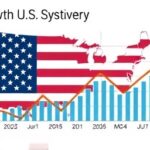In a robust display of market confidence, the S&P 500 and Nasdaq composite indices surged more than 2% each at the opening of November trading, propelled by heightened investor enthusiasm for artificial intelligence initiatives. This uptick marks a strong continuation of the tech-driven momentum that has characterized the stock market throughout the year, with Amazon’s shares notching a fresh all-time high amid reports of accelerated AI investment across major corporations.
The rally comes at a pivotal moment, as earnings season wraps up and eyes turn toward the Federal Reserve’s interest rate decisions. Traders point to Amazon’s impressive performance as a bellwether for the sector, with the e-commerce giant’s stock climbing 3.5% in early sessions to surpass previous peaks. This optimism is rooted in projections that corporate spending on AI technologies will exceed $200 billion by 2025, according to recent estimates from Gartner, underscoring the transformative potential of these investments.
Amazon’s AI-Powered Stock Surge Breaks Barriers
Amazon Web Services (AWS), the company’s cloud computing arm, has been at the forefront of the AI revolution, and its contributions were highlighted in the latest quarterly results. Shares of Amazon jumped to a record $185.50 during midday trading on Monday, reflecting a year-to-date gain of over 25%. Analysts attribute this milestone to AWS’s announcement of new AI tools integrated into its cloud platform, which are expected to drive revenue growth in the coming quarters.
“Amazon’s pivot toward AI is not just a buzzword; it’s a strategic imperative that’s paying off,” said Sarah Jenkins, a senior analyst at Bloomberg Intelligence. “With clients like Netflix and Capital One ramping up AI deployments on AWS, the revenue pipeline looks exceptionally strong.” Indeed, AWS reported a 19% year-over-year increase in sales during the third quarter, outpacing overall company growth and signaling robust demand for AI infrastructure.
Beyond AWS, Amazon’s e-commerce and advertising segments are also benefiting from AI enhancements. Machine learning algorithms are optimizing supply chains and personalizing customer experiences, leading to improved margins. The stock’s ascent has added approximately $50 billion to Amazon’s market capitalization in a single day, reinforcing its position as a leader in the stock market’s tech-heavy indices.
Historical context adds weight to this performance. Amazon’s previous record high was set in July 2021 at around $169 (pre-split adjusted), but the company has since executed a 20-for-1 stock split in June 2022. The current surge surpasses those levels, driven by a confluence of factors including easing inflation and renewed corporate AI investment. Investors are betting on Amazon’s ability to monetize AI across its diverse operations, from logistics to entertainment via Prime Video.
S&P 500 and Nasdaq Post Strong Gains Amid Tech Optimism
The broader stock market echoed Amazon’s enthusiasm, with the S&P 500 climbing 2.3% to close above 5,800 for the first time since mid-October. This marked the index’s best single-day performance in weeks, lifting blue-chip names like Microsoft and Alphabet alongside smaller tech players. The Nasdaq, heavily weighted toward technology, fared even better, surging 2.8% to approach 18,000, its highest level in over a month.
Key contributors to the S&P 500’s rally included semiconductor giants such as Nvidia and Advanced Micro Devices (AMD), whose chips power much of the AI ecosystem. Nvidia’s stock rose 4.2%, buoyed by reports of record orders for its AI data center products. The index’s technology sector, which comprises about 30% of the S&P 500, led the charge with gains exceeding 3%, while consumer discretionary stocks—home to Amazon—followed closely at 2.5%.
Market data from FactSet shows that 85% of S&P 500 companies reporting earnings so far have beaten expectations, a trend that AI investment is amplifying. The Nasdaq’s performance was similarly tech-centric, with the index’s top holdings accounting for over 50% of the day’s gains. “This isn’t a fleeting spike; it’s a validation of the AI thesis that’s been building since ChatGPT’s debut,” noted Mark Williams, chief market strategist at Capital Economics.
Trading volume spiked to 12 billion shares on the NYSE and Nasdaq combined, indicating widespread participation. Small-cap stocks, tracked by the Russell 2000, also participated modestly with a 1.2% increase, suggesting the rally’s benefits are trickling down beyond mega-caps. However, energy and utilities sectors lagged, down 0.5% and 0.8% respectively, as investors rotated into growth-oriented tech amid cooling geopolitical tensions.
Corporate AI Investment Fuels Long-Term Market Momentum
At the heart of the surge lies escalating corporate commitment to AI investment. A survey by McKinsey reveals that 65% of Fortune 500 companies plan to increase AI budgets by at least 20% in 2024, with cloud providers like Amazon, Microsoft, and Google Cloud capturing the lion’s share. This spending is projected to generate $15.7 trillion in global economic value by 2030, per PwC estimates, making AI a cornerstone of stock market valuations.
Amazon’s role in this ecosystem is pivotal. The company has invested over $10 billion in AI research and development this year alone, including partnerships with Anthropic to develop advanced language models. These initiatives are not isolated; they’re part of a broader wave where AI is infiltrating industries from healthcare to finance. For instance, JPMorgan Chase announced a $1 billion AI fund last week, citing efficiency gains that could boost productivity by 30%.
Regulatory scrutiny adds nuance to the narrative. The European Union’s AI Act, set for implementation in 2025, aims to balance innovation with ethics, potentially favoring established players like Amazon with robust compliance frameworks. In the U.S., the Biden administration’s executive order on AI safety could accelerate adoption while mitigating risks, further bolstering investor confidence in the S&P 500 and Nasdaq components.
Challenges persist, however. Supply chain bottlenecks for AI hardware have led to delays, and energy demands from data centers are straining grids. Yet, these hurdles are viewed as growing pains. “AI investment is the new oil for the economy,” quipped Elon Musk in a recent tweet, echoing sentiments from Wall Street where hedge funds have doubled down on AI-themed ETFs, which saw inflows of $5 billion last month.
Wall Street Analysts Predict Sustained AI-Driven Rally
Expert commentary underscores the rally’s durability. Goldman Sachs raised its S&P 500 year-end target to 6,000, citing AI as a primary catalyst. “The stock market’s tech sector is entering a multi-year expansion phase, with Amazon and peers leading the way,” the firm’s report stated. Similarly, JPMorgan analysts forecast Nasdaq gains of 15% over the next 12 months, driven by AI adoption rates surpassing 50% in enterprise settings.
Contrarian voices caution against overvaluation. The S&P 500’s forward P/E ratio stands at 22.5, above its historical average of 18, prompting warnings of a potential correction if interest rates remain elevated. Federal Reserve Chair Jerome Powell’s upcoming speech on November 7 could sway sentiment, with markets pricing in a 25-basis-point rate cut. “Optimism is high, but volatility looms if AI hype outpaces delivery,” advised Lisa Patel, portfolio manager at BlackRock.
Retail investors, empowered by platforms like Robinhood, are piling in, with AI-related searches on Google Trends up 40% week-over-week. Social media buzz around Amazon’s stock has amplified the narrative, with #AIInvestment trending globally. Institutional flows support this, as pension funds allocate 10-15% of portfolios to tech amid low bond yields.
Global implications are significant. The rally has lifted international indices, with Europe’s STOXX 600 up 1.5% and Asia’s Nikkei gaining 2%. U.S. tech dominance in AI positions the S&P 500 and Nasdaq as global benchmarks, influencing emerging markets’ strategies.
Looking Ahead: AI’s Role in Shaping Future Stock Market Trends
As November unfolds, the stock market’s trajectory hinges on upcoming catalysts. Amazon’s investor day on November 15 could unveil more AI innovations, potentially extending its record streak. Broader earnings from AI beneficiaries like Meta and Tesla will provide further readouts, with consensus expecting 12% S&P 500 earnings growth for the year.
Geopolitical factors, including U.S. elections, add uncertainty, but AI’s secular trend offers resilience. Projections from IDC indicate AI software spending will hit $100 billion annually by 2025, sustaining momentum in the Nasdaq and S&P 500. For investors, diversification into AI ETFs like the Global X Robotics & Artificial Intelligence ETF, up 30% YTD, presents opportunities.
In the long term, AI investment could redefine economic productivity, mirroring the internet boom of the 1990s. Amazon’s ascent symbolizes this shift, positioning the stock market for a new era of innovation-driven growth. Stakeholders from policymakers to CEOs must navigate this landscape carefully to harness AI’s full potential without exacerbating inequalities.
With corporate balance sheets flush and technological barriers lowering, the optimism fueling today’s rally appears well-founded. As AI permeates daily operations, expect the S&P 500, Nasdaq, and flagships like Amazon to remain at the vanguard, charting the course for global markets in the decade ahead.









